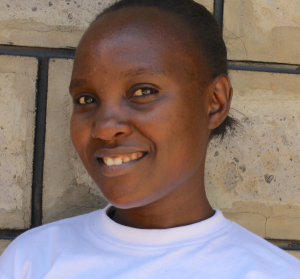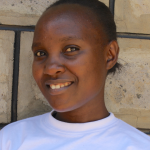Ateka Spring is located in Emaka Village of Kakamega County.
The community depends on subsistence farming. The women often are the ones who work on the farms each day. They plant crops such as sugarcane, maize, potatoes, vegetables. Some will plant small-scale cash crops, like tea.
The men in the community are motorcycle riders, watchmen, or car drivers. Most of them are rarely found at home because they usually leave the house in the wee hours of the morning and return at night.
Water
An Emaka village elder attended one of our trainings in the village and was very impressed with our work. After the training, she took us to her unprotected spring and asked us to vet it for protection.
Ateka Spring serves an estimated population of 214 people. The spring is the only reliable source of water in the community. During the dry seasons, large crowds of people gather at the spring and have to wait for hours to get water. The activity causes the water to turn turbid after a few scoops forcing people to wait for it to clear up.

The people draw water using jugs and pour them into 20-liter containers then lift it onto their heads to transport it to their homesteads. The water is stored in containers like pots and drums which are covered.

Since the spring is unprotected, it is open to contamination from surface runoff, people stepping into the spring as they fetch water, and the animals that drink from it. During the rainy seasons, surface runoff drains nutrients and chemicals from the nearby farms into the spring and this promotes algal bloom. The water turns green and must be drained frequently. This causes time wastage at the spring.
The community members report that they suffer from many cases of waterborne diseases like coughs, malaria, typhoid, diarrhea, and stomachaches as a result of drinking water from this unprotected spring.
Protecting this source will help reduce congestion at the spring and improve community health.
Sanitation
Sanitation is also a big problem - fewer than half of the households in the community do not have latrines. Most of the latrines that exist are made of mud floors and the superstructure is made of mud and iron sheets.
Some households throw trash on the farms, while others bury it in pits to compost and use later as farm manure.
The community requires training on good hygiene and sanitation practices so that they can live in a clean environment and maintain cleanliness of the spring.
Here’s what we’re going to do about it:
Training
Community members will attend hygiene and sanitation training for at least two days. This training will ensure participants have the knowledge they need about healthy practices and their importance. The facilitator plans to use PHAST (Participatory Hygiene and Sanitation Transformation), CLTS (Community-Led Total Sanitation), ABCD (Asset-Based Community Development), group discussions, handouts, and demonstrations at the spring. One of the most important topics we plan to cover is the handling, storage, and treatment of water. Having a clean water source will be extremely helpful, but it is useless if water gets contaminated by the time it’s consumed. Handwashing will also be a big topic.
Training will also result in the formation of a committee that will oversee operations and maintenance at the spring. They will enforce proper behavior around the spring and delegate tasks that will help preserve the site, such as building a fence and digging proper drainage. The fence will keep out destructive animals, and the drainage will keep the area’s mosquito population at a minimum.
Sanitation Platforms
On the final day of training, participants will select five families that should benefit from new latrine floors.
Training will also inform the community and selected families on what they need to contribute to make this project a success. They must mobilize locally available materials, such as bricks, clean sand, hardcore, and ballast. The five families chosen for sanitation platforms must prepare by sinking a pit for the sanitation platforms to be placed over. All community members must work together to make sure that accommodations and food are always provided for the work teams.
Spring Protection
Protecting the spring will ensure that the water is safe, adequate and secure. Construction will keep surface runoff and other contaminants out of the water. With the community’s high involvement in the process, there should be a good sense of responsibility and ownership for the new clean water source.
Fetching water is predominantly a female role, done by both women and young girls. Protecting the spring and offering training and support will, therefore, help empower the female members of the community by giving them more time and efforts to engage and invest in income-generating activities.

 Protected Spring
Protected Spring
 Rehabilitation Project
Rehabilitation Project








































